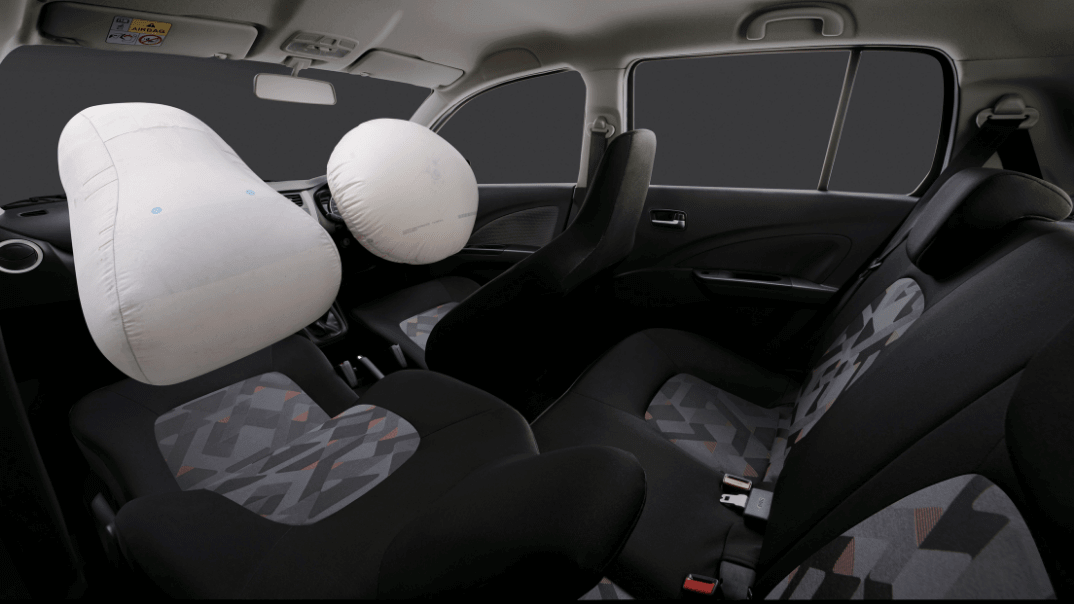 In this episode of How Things Work, we’re taking a look at your car’s passive safety systems, specifically airbags, seatbelts and other soft-touch elements in your car that help to keep you safe. Do you know what “SRS” on your airbag stands for, or even when your car’s airbags will deploy? Watch the video now and learn more about passive car safety.
In this episode of How Things Work, we’re taking a look at your car’s passive safety systems, specifically airbags, seatbelts and other soft-touch elements in your car that help to keep you safe. Do you know what “SRS” on your airbag stands for, or even when your car’s airbags will deploy? Watch the video now and learn more about passive car safety.
If you can’t watch the video, you can read the video transcription below:
Edited for clarity and readability
Welcome to part two of our segment on How Things Work on passive safety systems. And in this week's episode, we're going to take you through airbags, seatbelts, and some of the soft-touch elements that we see inside of our vehicles.
Let's kick off straight away with airbags and seatbelts. Seatbelts are known as our primary restraint system and airbags are known as our supplementary or secondary restraint system. And you might've even seen on some of the airbags, the letters ‘SRS’, and that's what that stands for.
So let's start with our seatbelts. Seatbelts have come a long way in terms of technology and design. And in fact, in the early days, seatbelts were pretty dangerous. And that's probably the reason why a lot of people today still feel like “I don’t want to wear a seatbelt”, but all things have changed on that and the designs are fantastic.
There are a couple of elements for us to consider when it comes to seatbelts. The first is, that seatbelts are a little bit wider than they were in the past. And I'm going to touch on that a little bit later. The second is, seatbelts are actually very stretchy. The third thing is seatbelts have pre-tensioners, which pull us back into our chairs with pyrotechnics. And the fourth thing is, is that seat belts also have load force limiters. So when we breach a certain force on the seat belt itself, it's going to allow us to continue moving forward without creating severe injuries for us.
Let's move on to our supplementary restraint system, which is our airbags. Now, the way that airbags work is fascinating. And I want to reference one of my favourite scientists Pascal, and he has a law that tells us that for the same force, the smaller, the surface area, that's acting on a surface, the greater the pressure.
So I want you to try and do this experiment yourself and take your index finger and push it onto your chest muscle hard. It's quite sore, isn't it? But if you take a flat hand with a bigger surface area now, and you push over here, you can hardly feel anything. And that's exactly what an airbag is doing for us.
When the airbag is inflated and we move forward, the airbag is taking the entire surface area of our upper body and absorbing all that force. And therefore we have less pressure. Now imagine the difference between that and the small surface area of your steering wheel and the forces that you would feel then. Now, the technology on airbags has increased in leaps and bounds, both from an electronics point of view, from a control unit point of view, and just the way that airbags work in general.
There are a few rules under which an airbag will only deploy. So first of all, if we have a look at the front impact of a vehicle, the airbag will only deploy if that impact is within 30 degrees of the centre line of the vehicle, anything beyond 30 degrees, the airbag control unit will consider that as a side-impact and in fact, your side-impact airbags will now deploy, not your front airbags. The second thing is that if a vehicle rolls over, it is highly unlikely that any of the airbags will deploy, except if you've got rollover mitigation technology on your vehicles.
And therefore the sensors that exist there will be able to deploy some of the airbags in the event of a rollover. And, if you get rear-ended in a vehicle, your front and side airbags are not going to deploy. So please, if you've had an accident in a vehicle and your airbags haven't deployed, the test is, were you severely injured in that accident?
And if the answer is no, then the airbags have done their job because you must remember the force and the veracity with which an airbag deploys, they're deploying it between three and 400 kilometres an hour. It's a bomb, essentially, that is going off. And so the acoustic damage that you will have as well is quite severe.
So you almost don't want an airbag to go off. It must be a last resort. Now a modern control unit on an airbag can determine a few interesting things. It can determine the speed of the vehicle that's hitting you as well as the weight of that vehicle hitting you. And then it's going to do some very interesting things because these days we have multi-stage airbags, which factor in those conditions, as well as the weight and the position of the person sitting on the seat.
So the seats in the vehicle itself have load sensors, which can determine where on the seat they sitting, how heavy the person is sitting on that seat, as well as, as I've said, the speed and the weight of the vehicle that is impacting into you.
And based on that, it is going to partially or fully deploy the airbags. So sensational stuff. And in fact, the latest generation airbags are now also working on staging, how they deflate. So currently airbags have two great big holes in them. So immediately that they inflate, they deflate but now they have valves on them that regulate at which rate they deflate. So sensational stuff on the airbags.
All right. So we've gone through the theory of airbags and seatbelts. Now, let's kind of have a look at them in action in the vehicle itself. So we have two main primary restraints systems. We have our seatbelt and airbags and our seatbelt is our primary restraint system. And our airbags are our supplementary restraint system. And you might've seen on some of the airbags that say SRS, and that's exactly what it stands for supplementary restraint system.
So having a look at the seatbelts first, modern seat belts are remarkably stretchy. I can't apply enough force now, but in an accident, my body weight would cause this belt to stretch slightly. And that's again, going to assist me to slow down slower and not have a sudden stop, which would cause injury.
The second thing that these seatbelts do is they have, what's called a pre-tensioner. That's a pyrotechnic device that exploded releases a gas. And as it releases the gas, it tensions up the seatbelt and puts me in the correct position to take full advantage of both the seatbelt and the airbag. And it also reduces any slack in the seatbelt. It would cause dramatic injury from impulse forces.
If I had to hit the seatbelt, if it was slack and nice pre-tensioning of the seatbelt puts me in the correct position, not as I experienced the forces on the seatbelt, as we've mentioned, the seatbelt material stretches slightly.
But the second thing it does is we have what's called a load force limiter. So if I exceed a certain force on the seatbelt, it is very, very tightly spring-loaded. So it's going to allow me to move slightly forward again with the seatbelt further, reducing the energy.
When it comes to the airbag, the way the airbag works is the airbag deploys very rapidly. Now, ultimately this airbag’s deploying at three to 400 kilometres per hour. If I'm not wearing a seatbelt, I'm going to meet the airbag while it's deploying and that's going to cause more injuries than good.
So it's very, very important that we have our seatbelt on to take advantage of the airbag because ultimately we want to impact the airbag as it's deflating. One of the things that I wanted to talk to is that there seems to be this old housewives' tale, that if your seatbelt is not properly anchored, that your airbags actually switch off and that's not the case, your airbags will still deploy, but it's obviously not first prize to be hitting the airbag when it's deploying as we said earlier.
Another thing that we don't necessarily realise about a modern vehicle is the fact that there's a lot of soft-touch elements inside the cockpit of the vehicle, which are designed to prevent supplementary injuries in the event of an impact. So one of the things that are going to happen, if I have a full-frontal impact is my arms are going to let go of the steering wheel and they're going to start flailing around and they're going to impact a lot of these surfaces quite hard. And you'll notice that all these surfaces, whether it's these switches over here, the indicator stalks, or even the sides of the vehicle are all nice and soft touch.
And that's designed, as I said, to prevent supplementary injuries, which is very, very cool. All right. So we've just had a look at some of the basic passive safety features on a vehicle. So the chassis, the airbags, seatbelts, and some of the soft-touch elements, but there's a lot more exciting design work that's gone into some of the passive safety features. And we certainly are going to have a look at those in future episodes of how things work. So until next time see you then.
To watch the full episode, visit: https://www.facebook.com/watch/LetsTalkAutomotive/
Want to know when the next episode is available? Sign up to get notifications straight into your inbox.



![How Things Work: ESP [VIDEO]](https://blog.suzukiauto.co.za/hubfs/How%20things%20work%20ESP.png)